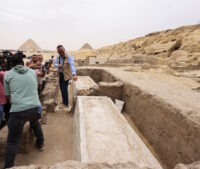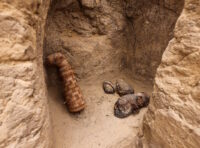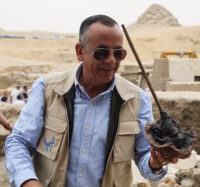 Two ancient embalming workshops, one for humans and one for animals, have been discovered at the necropolis of Saqqara southeast of Cairo. The workshops, found beneath a hill near the temple of the cat goddess Bastet, date to the 30th dynasty (380-343 B.C.) and the Ptolemaic dynasty (305-30 B.C.).
Two ancient embalming workshops, one for humans and one for animals, have been discovered at the necropolis of Saqqara southeast of Cairo. The workshops, found beneath a hill near the temple of the cat goddess Bastet, date to the 30th dynasty (380-343 B.C.) and the Ptolemaic dynasty (305-30 B.C.).
 The workshops were rectangular in overall shape and divided into rooms that were used for different stages of the mummification process. The animal mummification workshop was made of mud and stone floors. Five stone beds were still inside the room, used to embalm the bodies of sacred animals . Mummification tools and materials were also found in the space.
The workshops were rectangular in overall shape and divided into rooms that were used for different stages of the mummification process. The animal mummification workshop was made of mud and stone floors. Five stone beds were still inside the room, used to embalm the bodies of sacred animals . Mummification tools and materials were also found in the space.
 The human mummification workshop had stone beds as well, albeit larger. They are 6.5 feet long by 20 inches wide. Bodies were laid out on the beds for the mummification process — the cleaning of the body, the removal of organs, the application of embalming fluids. A number of materials, including wooden stirring sticks, rolls of linens, clay pots containing nitrate salts and black resin were found in the workshop.
The human mummification workshop had stone beds as well, albeit larger. They are 6.5 feet long by 20 inches wide. Bodies were laid out on the beds for the mummification process — the cleaning of the body, the removal of organs, the application of embalming fluids. A number of materials, including wooden stirring sticks, rolls of linens, clay pots containing nitrate salts and black resin were found in the workshop.
The team also discovered two tombs, one from the Old Kingdom, one from the New. The New Kingdom tomb belonged to an 18th Dynasty priest named Men Kheber. He died around 1400 B.C. Vividly-colored paintings in his tomb depict the deceased engaged in different functions.
Inscriptions in the Old Kingdom tomb identify its owner as Ne Hesut Ba, 5th Dynasty head scribe and priest of Horus and Maat who died in around 2400 B.C. In addition to his duties as priest and scribe, Ne Hesut Ba was in charge of digging waterways for the pharaoh. An alabaster statue depicting him was found inside a niche of the tomb, and wall paintings depict him engaged in religious rituals and activities from daily life.